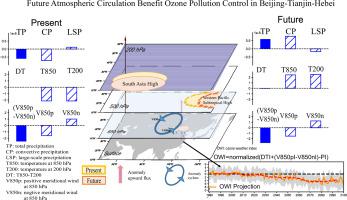Science of the Total Environment ( IF 9.8 ) Pub Date : 2020-06-30 , DOI: 10.1016/j.scitotenv.2020.140645 Bufan Cao 1 , Zhicong Yin 2

|
Surface ozone pollution has become increasingly serious in recent years. Ozone pollution will damage human health and reducing social productivity in China. Basing on an ozone weather index (OWI) that captured the effects of climate on the ground-level ozone, large ensemble simulations by the Community Earth System Model were introduced to project future impacts of atmospheric circulation on ozone pollution in Beijing-Tianjin-Hebei in late-21st century. In the future, atmospheric circulations will favour the control of ozone pollution in Beijing-Tianjin-Hebei region. The OWI decreased overall during the 21st century, which was nearly ignored by other studies on ozone projections. The OWI decrease was mainly due to the increase in regional precipitation and partly due to the changes of wind and the temperature difference between 200 hPa and lower-troposphere. The increased total precipitation in the 21st century, mainly due to the increase in convectional precipitation, weakened the production of surface ozone by its shading effect (related to more cloud cover) and wet deposition impact. During 2061–2100, the South Asia High will move southward, and the west Pacific subtropical high will shift eastward; thus, the convergence of water vapour will mainly occur in South China. Consequently, the large-scale precipitation will decrease over northern China. However, because of climate warming, the increase in specific humidity in Beijing-Tianjin-Hebei region (BTH) will enhance convectional precipitation, which will be more than 4 times the decrease in large-scale precipitation.

























 京公网安备 11010802027423号
京公网安备 11010802027423号